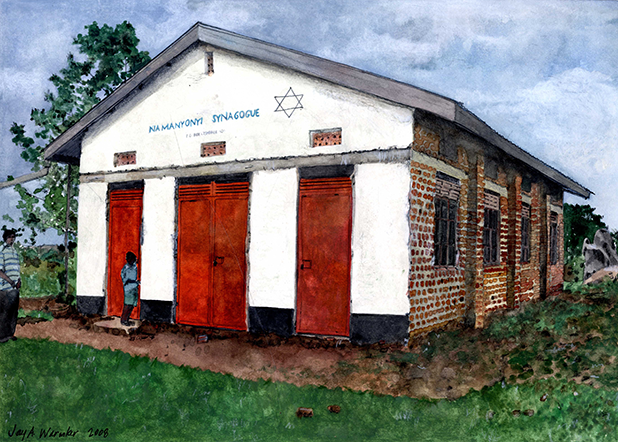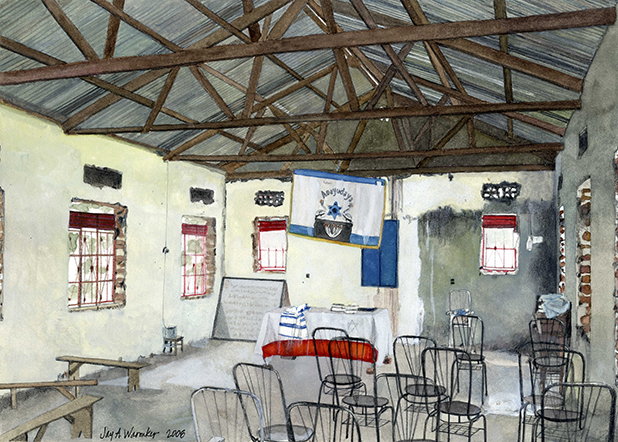 Exterior View (2008), 15” x 11” Watercolor, Jay A. Waronker
Exterior View (2008), 15” x 11” Watercolor, Jay A. Waronker
uganda
Synagogue (1990s) |
|

Interior View (2008), 11” x 15” Watercolor, Jay A. Waronker
|
Uganda is home to the Abayudaya (from the Lugandan word for “Jewish People” or “People of Judah”) community of Jews, a group made up of the large Bantu ethnic group native to Buganda, a subnational kingdom within the country. The black Abayudaya Jews live not at a single place in this region but in a string of unassuming and peaceful villages in the eastern part of Uganda near the border with Kenya. There a collection of modest synagogues building over fairly recent years can today be found. These Jewish houses of prayer are located to the east of Mbale, Uganda’s seventh largest city and the main municipal, administrative, and commercial center of Mbale District and the surrounding sub-region.
Christian and Muslim neighbors once looked on the Abayudaya with contempt, but inter-faith relations in recent times have improved, and some now view members of the Abayudaya with respect and admiration. Whereas the Abayudaya Jewish population was estimated at three hundred individuals at the time of the fall of Idi Amin in 1979, the community is said to now number up to two thousand people.
Besides the five synagogues located in the towns of Namutumba, Nasenyi, Putti, Namanyonyi, and Nabugoye, Abayudaya Jewish schools have been established in recent years with outside help from individuals and international Jewish organizations such as Kulanu. As the Abayudaya community has increased its interactions with outside Jews, mainly those from the United States and Israel, over the past dozen or so years, its religious ideology and customs has shifted towards more mainstream and normative Judaism. Members attend Shabbat services regularly following a conventional prayer book, maintain a kosher diet and slaughter their own animals in accordance with its regulations and, out of character from most Jews, remove their shoes before entering the synagogue in reverence to a practice by Jews in biblical times.
The Namanyonyi Synagogue, larger than most other Abayudaya Jewish houses of prayer, is built on a brick foundation and constructed out of locally-made rough bricks, a buff-colored stucco veneer along the front facade, painted black base, a corrugated galvanized metal gable roof set on hand-cut wood framing, wood-framed openings with painted metal security bars but no glass window units, and solid metal doors painted an orange-red. At the front façade is the hand-painted name of the synagogue, a Star of David, and the building’s address. Above the windows and doors towards the peak of the gabled front are clay vents. Unlike most other Abayudaya synagogues, this sanctuary is wired for electricity. The building is set on a flat grassy and dirt site surrounding by a few small trees and plants. Out in the distance are expansive and beautiful of the Ugandan countryside, including some of undisturbed land where cattle grazes, with the mountains far away.
Today the Jewish population of Namanyonyi is said to number a few hundred members, and prayer services are held here regularly on Friday evenings and Saturday mornings. If a minyan (quorum) can be arranged, Monday and Thursday morning services are also conducted here.
The synagogue is a one-room structure measuring 20’ x 40’. It contains a concrete floor, hand-made brick walls, and simple wood roof framing exposed on the inside covered of the galvanized corrugated metal roof. The space is larger than most other Abayudayan synagogues: 11’-2” high walls sloping up to 16’ along the roof ridge, unpainted plaster walls, ten wood-framed openings with security bars yet without proper glass window units, a vent panel above the window openings made up of perforated bricks, and two single and one pair of metal doors painted a red-orange along the southern side of the building. The space is filled several tubular aluminum chairs used by the men, wooden benches for the women since they sit separately from the men, some wooden bookshelves and a table, a wood-framed bimah (table where the Torah is read), and an ark intended to house the Sefer Torah. Since the wood doors of the ark, painted blue, are coplanar with the north wall of the synagogue, the cabinet space is expressed in the form of a bumped-out niche on the building’s exterior. The synagogue’s walls are mostly bare, yet there are a few holiday liturgical as well as community-specific decorative flourishes – such as a congregational banner – in the otherwise very modest space.
Weekly Friday night and Saturday morning Shabbat services are held here, and Monday and Thursday prayers are also conducted in the sanctuary whenever there is a minyan (quorum). The community has a small Sefer Torah, and a local member by the name of Phinehas serves as the hazan (cantor).
